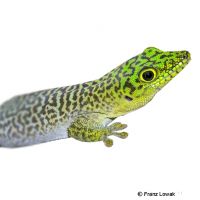Standing's Day Gecko (Phelsuma standingi)
| Standing's Day Gecko Phelsuma standingi | |
|---|---|
| Name | Standing's Day Gecko |
| Name Lat. | Phelsuma standingi |
| Family | Geckos |
| Family lat. | Gekkonidae |
| Order | Scaled Reptiles |
| Order lat. | Squamata |
| Origin | Madagascar |
| Habitat | Thorn forests, shrubland |
| Diet | Insects, fruits |
| Humidity | 50-65 % |
| Behavior | ♂ territorial |
| Keeping | Individual, harem |
| Care Level | Moderate |
| Reproduction | Oviparous |
| Housing | Dry terrarium |
| Life Span | 10-20 years |
| Protection | CITES Appendix II; EU Annex B |
| Metric Units | |
| Size | 26 cm |
| Temperature | 24-30 °C |
| Temperature Local | 35-40 °C |
| Housing Size | 90 x 90 x 120 cm |
| US Units | |
| Size | 10" |
| Temperature | 75-86 °F |
| Temperature Local | 95-104 °F |
| Housing Size | 35" x 35" x 45" |
Distribution and habitat
The diurnal cross-striped day geckos are distributed in the southwest of Madagascar. They live in the sparse thorn forests with their typical succulent flora, where they mostly stay on trees and shrubs and as cultural followers in gardens and houses.
Maintenance
Minimum dimensions for the terrarium, according to the size and number of animals
| 1-2 animals | 6KRL x 6KRL x 8KRL (L x W x H) |
Head-torso length (KRL) is measured on the largest animal. For each additional animal, increase the footprint by 15%. A terrarium of e.g. 90 x 90 x 120 cm is recommended, which should be placed in a quiet and vibration-free place.
They need a terrarium with partly vertical climbing branches and branch hollows as well as plants, like succulents etc. (hiding and shadow places), structured back and side walls (e.g. cork lining), a substrate of forest soil-peat mixture and a small water basin. Once a day, preferably in the evening, the terrarium should be finely sprayed with water inside (humidity), but a rain or fog system is better. At night increase the humidity to 80%.
| Temp. day: 24-30 °C | Temp. night: 20-23 °C | Temp. local: up to 40 °C | Humidity: 50-65 % |
Thermostatically controlled floor heating is recommended. Lighting duration must be 10-14 hrs depending on the season. They need high light intensity and daily UV irradiation as well as sunny places with radiant heat.
Diet
The diet consists of live insects, such as crickets, house crickets, grasshoppers, cockroaches, zophobas and mealybug larvae; alternatively, special ready-made food for geckos or insectivorous reptiles can be offered, supplemented with some fruit pulp, sweet fruits (e.g. bananas, papaya), flower pollen and honey (lick bowls). Wax moths should rarely be fed in very small amounts because of their large fat content. Young animals should be offered food daily, adults 4-5 times a week. Regular addition of minerals and vitamins (dusting of feed) is important. Drinking water must always be available, but is preferably taken in drop form from leaves or furnishings. A regular and varied diet promotes health and prevents deficiency symptoms.
Reproduction and breeding
Males have enlarged scale seams (preanofemoral pores) running from the cloacal opening along the inner thighs.
The female lays her hard-shelled eggs (2 eggs) in hidden and protected places, such as rock crevices or branch forks. The incubation period is strongly temperature dependent and is 55-65 days at a temperature of 25-27 °C. Small insects, such as fruit flies and micro crickets, are suitable as initial food for the young. The life expectancy can be 10-20 years.
Species protection
The animal population must be reported to the competent authority in writing immediately after the start of keeping. Your pet store will be happy to provide you with further information.
Protection of species: WA Appendix II; EU Appendix B. The proof of purchase is the required proof of origin for the animal. Please keep it safe!
Important
With their lamellar toes (adhesive toes) they can also climb on smooth, vertical surfaces (e.g. glass).
Adult males behave very territorial and are incompatible with each other
For the resting phase, shorten the lighting duration by 2-3 hours and lower the temperature by 3-4 °C for about two months.
With fruit and honey water as food for the feeders, their quality can be upgraded.
The terrarium must have good ventilation without drafts and meet the species specific needs. Measuring devices such as thermometers, hygrometers, etc. are necessary. The lighting has to correspond to the species-specific day-night rhythm and has to be placed in such a way that the animals cannot injure themselves. The terrarium should be locked in such a way that neither unauthorized persons can open it nor the animals can escape. Contamination must be removed regularly.
Further literature can be found in your pet store.
References
Text: petdata; Image: Franz Lowak
Source: BMELV (1997): Tierschutzgutachten - Mindestanforderungen an die Haltung von Reptilien; ENGELMANN (2006): Zootierhaltung - Tiere in menschlicher Obhut: Reptilien und Amphibien, Harri Deutsch Verlag
- Gemäß § 21 Abs. 5 Tierschutzgesetz idgF
